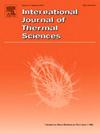Improving channel layouts in printed circuit heat exchangers for efficient supercritical carbon dioxide cooling
IF 4.9
2区 工程技术
Q1 ENGINEERING, MECHANICAL
International Journal of Thermal Sciences
Pub Date : 2025-04-23
DOI:10.1016/j.ijthermalsci.2025.109932
引用次数: 0
Abstract
An analysis is conducted to investigate the impact of channel layouts in a Printed Circuit Heat Exchanger (PCHE) on the cooling process of supercritical carbon dioxide (CO2) using water (H2O). Sixteen different models are evaluated under two cooling conditions: one far from the pseudo-critical point and the other near it. To assess the performance of the PCHE, a conjugate heat transfer model is solved using the finite volume method. The variations in the thermo-physical properties of supercritical CO2 are obtained from the NIST REFPROP database. The findings reveal that reducing the channel diameter has a more significant impact on the thermal performance of the cold-side than the hot-side. Under cooling conditions far from the pseudo-critical point, this reduction increases the heat transfer coefficient by 43.5 % on the cold-side and by 8.4 % on the hot-side. However, this effect on the hot side becomes increasingly pronounced as CO2 approaches the pseudo-critical point. Under the specified cooling conditions, flipping only the hot-side plate enhances CO2 cooling efficiency by improving synergy and mitigating heat transfer deterioration. Notably, this modification results in a 7.12 % improvement in the overall performance of the PCHE. This configuration is particularly effective when cooling conditions are near the pseudo-critical point and when the channel diameter is reduced. The optimal channel layout is influenced by the channel diameter. For heat transfer plates with large and equally sized channel diameters, flipping only the hot-side plate achieves the highest overall performance, with an improvement of approximately 6.87 %. In contrast, for heat transfer plates with small and equally sized channel diameters, simultaneously flipping both the hot-side and cold-side plates yields superior performance, with an improvement of approximately 7.11 %. Furthermore, when dealing with heat transfer plates of different channel diameters, it is recommended to flip only the hot-side plate.
改进印刷电路热交换器的通道布局,以实现高效的超临界二氧化碳冷却
分析了印刷电路热交换器(PCHE)中通道布局对超临界二氧化碳(CO2)用水冷却过程的影响。在远离伪临界点和靠近伪临界点两种冷却条件下,对16种不同的模型进行了评估。为了评估PCHE的性能,采用有限体积法求解了一个共轭传热模型。超临界CO2的热物理性质变化从NIST REFPROP数据库中获得。结果表明,减小通道直径对冷侧热工性能的影响比对热侧热工性能的影响更显著。在远离伪临界点的冷却条件下,这一降低使冷侧和热侧的换热系数分别提高了43.5%和8.4%。然而,当二氧化碳接近伪临界点时,这种效应在热侧变得越来越明显。在规定的冷却条件下,仅翻转热侧板可以通过提高协同效应和减轻传热恶化来提高CO2冷却效率。值得注意的是,这一修改使PCHE的整体性能提高了7.12%。当冷却条件接近伪临界点和通道直径减小时,这种配置特别有效。最优通道布局受通道直径的影响。对于具有大且相同尺寸通道直径的传热板,仅翻转热侧板可获得最高的整体性能,改进约为6.87%。相比之下,对于具有小而相同尺寸通道直径的传热板,同时翻转热侧和冷侧板可获得更优的性能,提高约7.11%。此外,当处理不同通道直径的传热板时,建议只翻转热侧板。
本文章由计算机程序翻译,如有差异,请以英文原文为准。
求助全文
约1分钟内获得全文
求助全文
来源期刊

International Journal of Thermal Sciences
工程技术-工程:机械
CiteScore
8.10
自引率
11.10%
发文量
531
审稿时长
55 days
期刊介绍:
The International Journal of Thermal Sciences is a journal devoted to the publication of fundamental studies on the physics of transfer processes in general, with an emphasis on thermal aspects and also applied research on various processes, energy systems and the environment. Articles are published in English and French, and are subject to peer review.
The fundamental subjects considered within the scope of the journal are:
* Heat and relevant mass transfer at all scales (nano, micro and macro) and in all types of material (heterogeneous, composites, biological,...) and fluid flow
* Forced, natural or mixed convection in reactive or non-reactive media
* Single or multi–phase fluid flow with or without phase change
* Near–and far–field radiative heat transfer
* Combined modes of heat transfer in complex systems (for example, plasmas, biological, geological,...)
* Multiscale modelling
The applied research topics include:
* Heat exchangers, heat pipes, cooling processes
* Transport phenomena taking place in industrial processes (chemical, food and agricultural, metallurgical, space and aeronautical, automobile industries)
* Nano–and micro–technology for energy, space, biosystems and devices
* Heat transport analysis in advanced systems
* Impact of energy–related processes on environment, and emerging energy systems
The study of thermophysical properties of materials and fluids, thermal measurement techniques, inverse methods, and the developments of experimental methods are within the scope of the International Journal of Thermal Sciences which also covers the modelling, and numerical methods applied to thermal transfer.
 求助内容:
求助内容: 应助结果提醒方式:
应助结果提醒方式:


